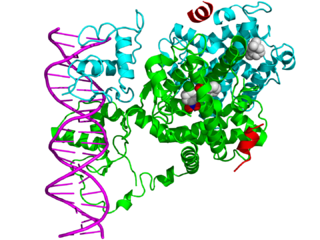Related Research Articles
Essential fatty acids, or EFAs, are fatty acids that humans and other animals must ingest because the body requires them for good health but cannot synthesize them.

The retinoids are a class of chemical compounds that are vitamers of vitamin A or are chemically related to it. Retinoids have found use in medicine where they regulate epithelial cell growth.

Retinoic acid (used simplified here for all-trans-retinoic acid) is a metabolite of vitamin A1 (all-trans-retinol) that mediates the functions of vitamin A1 required for growth and development. All-trans-retinoic acid is required in chordate animals, which includes all higher animals from fish to humans. During early embryonic development, all-trans-retinoic acid generated in a specific region of the embryo helps determine position along the embryonic anterior/posterior axis by serving as an intercellular signaling molecule that guides development of the posterior portion of the embryo. It acts through Hox genes, which ultimately control anterior/posterior patterning in early developmental stages.
The effects of the ω-3 (omega-3) and ω-6 (omega-6) essential fatty acids (EFAs) are characterized by their interactions.
The retinoic acid receptor (RAR) is a type of nuclear receptor which can also act as a transcription factor that is activated by both all-trans retinoic acid and 9-cis retinoic acid. There are three retinoic acid receptors (RAR), RAR-alpha, RAR-beta, and RAR-gamma, encoded by the RARA, RARB, RARG genes, respectively. Multiple splice variants have been identified in human RARs: four for RARA, five for RARB, and two for RARG. As with other type II nuclear receptors, RAR heterodimerizes with RXR and in the absence of ligand, the RAR/RXR dimer binds to hormone response elements known as retinoic acid response elements (RAREs) complexed with corepressor protein. Binding of agonist ligands to RAR results in dissociation of corepressor and recruitment of coactivator protein that, in turn, promotes transcription of the downstream target gene into mRNA and eventually protein. In addition, the expression of RAR genes is under epigenetic regulation by promoter methylation.
The retinoid X receptor (RXR) is a type of nuclear receptor that is activated by 9-cis retinoic acid, which is discussed controversially to be of endogenous relevance, and 9-cis-13,14-dihydroretinoic acid, which is likely to be the major endogenous mammalian RXR-selective agonist.

The liver X receptor (LXR) is a member of the nuclear receptor family of transcription factors and is closely related to nuclear receptors such as the PPARs, FXR and RXR. Liver X receptors (LXRs) are important regulators of cholesterol, fatty acid, and glucose homeostasis. LXRs were earlier classified as orphan nuclear receptors, however, upon discovery of endogenous oxysterols as ligands they were subsequently deorphanized.

In the field of molecular biology, nuclear receptors are a class of proteins responsible for sensing steroids, thyroid hormones, cholesterol, and vitamins. These receptors work with other proteins to regulate the expression of specific genes thereby controlling the development, homeostasis, and metabolism of the organism.
The RAR-related orphan receptors (RORs) are members of the nuclear receptor family of intracellular transcription factors. There are three forms of ROR, ROR-α, -β, and -γ and each is encoded by a separate gene RORA, RORB, and RORC respectively. The RORs are somewhat unusual in that they appear to bind as monomers to hormone response elements as opposed to the majority of other nuclear receptors which bind as dimers. They bind to DNA elements called ROR response elements (RORE).

The nuclear receptor 4A1 also known as Nur77, TR3, and NGFI-B is a protein that in humans is encoded by the NR4A1 gene.

The germ cell nuclear factor (GCNF), also known as RTR or NR6A1, is a protein that in humans is encoded by the NR6A1 gene. GCNF is a member of the nuclear receptor family of intracellular transcription factors.

RAR-related orphan receptor beta (ROR-beta), also known as NR1F2 is a nuclear receptor that in humans is encoded by the RORB gene.

RAR-related orphan receptor alpha (RORα), also known as NR1F1 is a nuclear receptor that in humans is encoded by the RORA gene. RORα participates in the transcriptional regulation of some genes involved in circadian rhythm. In mice, RORα is essential for development of cerebellum through direct regulation of genes expressed in Purkinje cells. It also plays an essential role in the development of type 2 innate lymphoid cells (ILC2) and mutant animals are ILC2 deficient. In addition, although present in normal numbers, the ILC3 and Th17 cells from RORα deficient mice are defective for cytokine production.

Retinoid X receptor alpha (RXR-alpha), also known as NR2B1 is a nuclear receptor that in humans is encoded by the RXRA gene.

Retinoic acid receptor alpha (RAR-α), also known as NR1B1 is a nuclear receptor that in humans is encoded by the RARA gene.

Retinoid X receptor gamma (RXR-gamma), also known as NR2B3 is a nuclear receptor that in humans is encoded by the RXRG gene.

Retinoid X receptor beta (RXR-beta), also known as NR2B2 is a nuclear receptor that in humans is encoded by the RXRB gene.

Retinoic acid receptor gamma (RAR-γ), also known as NR1B3 is a nuclear receptor encoded by the RARG gene. Adapalene selectively targets retinoic acid receptor beta and retinoic acid receptor gamma and its agonism of the gamma subtype is largely responsible for adapalene's observed effects.

CGP 52608 is a selective ligand of the RAR-related orphan receptor alpha. CGP 52608 has also been reported to possess antiarthritic activity.
Omega hydroxy acids are a class of naturally occurring straight-chain aliphatic organic acids n carbon atoms long with a carboxyl group at position 1, and a hydroxyl at terminal position n where n > 3. The C16 and C18 omega hydroxy acids 16-hydroxy palmitic acid and 18-hydroxy stearic acid are key monomers of cutin in the plant cuticle. The polymer cutin is formed by inter-esterification of omega hydroxy acids and derivatives of them that are substituted in mid-chain, such as 10,16-dihydroxy palmitic acid. Only the epidermal cells of plants synthesize cutin.